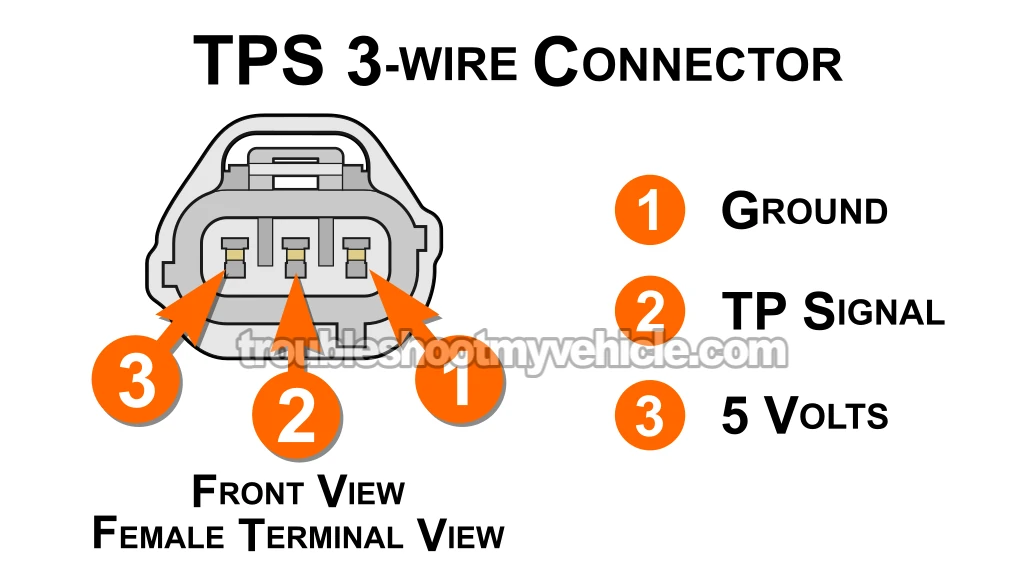TEST 2: Making Sure The TPS Is Receiving 5 Volts

If the TPS voltage signal doesn't change as you open and close the throttle plate, there's a good chance it's not getting power.
For our second test, we'll verify that the purple wire with white stripe (PPL/WHT) is supplying between 4.5 and 5 Volts DC.
In the TPS 3-wire connector illustration above, I've marked the terminal connected to the PPL/WHT wire as terminal 3.
To confirm the PPL/WHT wire is actually delivering 5 Volts, we'll do a simple voltage test with our multimeter.
Let's get right to it!
- 1
Disconnect the TP sensor from its connector.
- 2
Set your multimeter to DC Volts mode.
- 3
Connect the black multimeter test lead to the negative (-) battery terminal.
- 4
Turn the key to the ON position, but don't start the engine.
- 5
Gently probe female terminal 3 of the TP sensor's 3-wire connector with the red multimeter test lead.
NOTE: Make sure that the PPL/WHT wire is the one connected to terminal number 3. - 6
You should see a voltage reading between 4.5 and 5 Volts DC on your multimeter.
OK, let's take a look at your test results.
CASE 1: You're getting between 4.5 and 5 Volts. This tells us the TPS is actually getting power and that's exactly what we need see!
For our final test, we'll check that the TPS is getting Ground. Head over to: TEST 3: Making Sure The TPS Is Receiving Ground.
CASE 2: You're NOT seeing 4.5 to 5 Volts. Without power, your TP sensor just won't produce a variable voltage signal.
So, what's causing this missing voltage? The most common causes are:
- There's an open-circuit problem in the PPL/WHT somewhere between your TP sensor's 3-wire connector and the fuel injection computer's connector.
- In some rare cases, the computer itself has an internal problem.
I don't cover how to actually troubleshoot this in this tutorial. But, you now know the TP sensor itself is working fine. Your job is to figure out what's stopping that voltage from getting to the sensor.
TEST 3: Making Sure The TPS Is Receiving Ground

Based on the last two tests, you've confirmed:
- Opening and closing the throttle plate has no effect on the TPS voltage signal (TEST 1).
- The sensor is getting power (TEST 2).
Now, for this final test, we'll check whether the black with light blue stripe (BLK/LT BLU) wire is supplying Ground to the TPS.
In the illustration above, the terminal labeled with the number 1 is where the BLK/LT BLU wire connects.
We'll do a simple multimeter voltage test to see if the BLK/LT BLU wire is providing Ground.
IMPORTANT: The fuel injection computer supplies Ground to this sensor circuit. Do not, under any circumstances, connect this wire directly to 12 Volts from the battery or you'll fry the computer! The multimeter test I'm outlining in the steps below lets you safely confirm the presence of Ground in the circuit.
Here's how to check for Ground:
- 1
Disconnect the TP sensor from its connector.
- 2
Set your multimeter to DC Volts mode.
- 3
Connect the red multimeter test lead to the positive (+) battery terminal.
- 4
Turn the key to the ON position, but don't start the engine.
- 5
Gently probe female terminal 1 of the TP sensor's 3-wire connector with the red multimeter test lead.
NOTE: Make sure that the BLK/LT BLU wire is the one connected to terminal number 1. - 6
You should see a voltage reading between 10 to 12 Volts DC on your multimeter.
Let's take a look at what your test results mean:
CASE 1: Multimeter read 10 to 12 Volts. This is the correct and expected test result.
The TP sensor is bad if you've checked and confirmed the following conditions:
- The TP sensor's signal doesn't change when you move the throttle plate (TEST 1).
- The TP sensor is receiving 4.5 to 5 Volts (TEST 2).
- The TP sensor is getting Ground (this test section).
CASE 2: You're NOT seeing 10 to 12 Volts. Without Ground, your TP sensor just won't produce a variable voltage signal.
So, what's causing this missing Ground? The most common causes are:
- There's an open-circuit problem in the BLK/LT BLU somewhere between your TP sensor's 3-wire connector and the fuel injection computer's connector.
- In some rare cases, the computer itself has an internal problem.
I don't cover how to actually troubleshoot this in this tutorial. But, you now know the TP sensor itself is working fine. Your job is to figure out what's stopping that Ground from getting to the sensor.
More 3.9L V6 Dodge Ram Van Tutorials
You can find a complete list of 3.9L V6 Dodge Ram van tutorials in this index:
Here's a small sample of the tutorials you'll find in the index:
- How To Test The Engine Compression (1989-2003 3.9L V6 Dodge Ram Van).
- How To Test For A Blown Head Gasket (1989-2003 3.9L V6 Dodge Ram Van).
- How To Test The Fuel Pump (1992-2003 3.9L V6 Dodge Ram Van).
- How To Test The TPS (1989-1990 3.9L V6 Dodge Ram Van.

If this info saved the day, buy me a beer!

